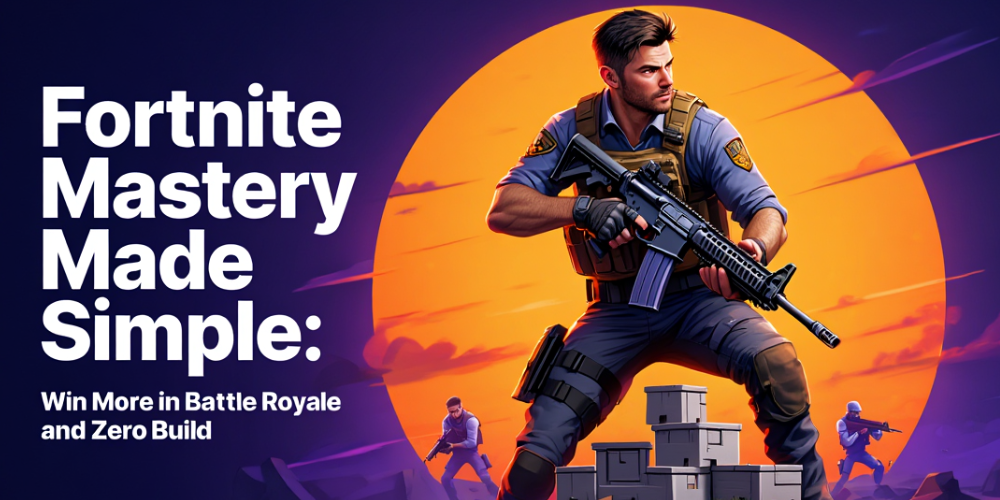Fortnite Mastery Made Simple: Win More in Battle Royale and Zero Build
2025-08-11

Drop in, gear up, and take over the island. If you want faster wins, smoother fights, and smarter rotations in Fortnite, this guide is your shortcut. Whether you love building or prefer the clean combat of Zero Build, you’ll get clear steps to improve today.
Think of this as your friendly coach: simple language, practical tips, and no fluff. We’ll cover landing decisions, loadouts, aiming, movement, building, Zero Build tactics, team play, endgame strategy, and settings that boost your performance—on controller, mouse, or mobile.
How Fortnite Works (Quick Overview)
Fortnite is a fast battle royale: up to 100 players drop onto an island, loot weapons and items, and fight while a storm circle shrinks. Survive to be the last player or team alive. You can play solo, duo, trios, or squads. There are two main combat styles:
- Battle Royale (Building On): gather materials, build cover, edit for angles.
- Zero Build: no building; positioning, aim, and mobility tools matter most.
Game Modes You Should Know
- Battle Royale: classic mode with building and editing.
- Zero Build: same map and loot but without building.
- Ranked: climb divisions by earning placement and elimination points.
- Creative/Islands: practice aim, building, editing, and realistic fights.
- Team Rumble/Other LTMs: casual ways to warm up and complete quests.
Settings That Give You an Edge
Performance and Video
- Frame rate first: lower graphics to keep FPS stable (60/120+). Smooth frames help aim and build speed.
- Performance Mode (PC): boosts FPS on lower-end systems.
- Turn off motion blur; keep a clean, sharp image.
Audio
- Turn on Visualize Sound Effects to see footsteps, shots, and chests.
- Use headphones; sound cues often win fights before they start.
Controller Tips
- Try Linear input for direct stick response; Exponential is smoother. Pick one and stick with it for a week.
- Start sensitivity moderate; adjust slowly. If you miss close shots, lower look sensitivity a bit.
- Use custom binds for faster building and editing. Keep important actions on bumpers/triggers and paddles if available.
Keyboard and Mouse Tips
- Lower to medium mouse sensitivity helps tracking. Use a large mousepad.
- Bind build pieces to easy keys or mouse side buttons.
- Consider “Edit on Release” for faster edits; practice until consistent.
Drop Strategy: Start Strong
Your first 60 seconds can decide the match. Plan your drop before the bus launches.
- Pick a POI you know: learn 2–3 chest spawns, floor loot spots, and quick mats routes (for build mode).
- Land first: deploy glider late by diving down sharply; aim for the roof with a guaranteed weapon/chest.
- Avoid hot chaos at first: if you are new, land near the edge of a big POI, third-party fights, and clean up.
- Grab early shields: aim to reach 150–200 effective HP (health + shield) before pushing.
Loot, Rarity, and a Smart Inventory
Weapons come in rarities (Common to Mythic). Higher rarity usually means more damage, better fire rate, or stability. But a smart loadout matters more than color alone.
- Shotgun for close range: your clutch weapon for box fights and room pushes.
- SMG or AR for spray: follow up after a shotgun shot or beam at mid-range.
- Long-range piece: DMR, sniper, or marksman for tags and pressure.
- Mobility: carry one slot for movement (shockwaves, grapples, launch items, vehicles when possible).
- Heals: at least one heal slot—shields early, then mix in white heals (meds) if storm damage is likely.
Example balanced loadout: Shotgun, AR/DMR, SMG or utility, mobility item, heals.
Combat Basics: Aim, Recoil, and Peeks
Aim Fundamentals
- Crosshair discipline: keep your crosshair head-height where enemies might appear.
- Pre-aim corners: snap your aim before you expose yourself.
- Shotgun timing: wait a split second for a tighter spread; don’t panic fire mid-jump.
Recoil and Weapon Control
- Short bursts with ARs/DMRs to keep accuracy high.
- Track movement: strafe left-right smoothly while adjusting your aim.
Better Angles
- Right-hand peek advantage: in Fortnite, peeking from the right gives more vision with less exposure.
- Head glitches: use natural cover so only your head shows; crouch and stand to shoot safely.
- Third-party smartly: wait for reload/knock sounds, then push when both sides are weak.
Movement That Wins Fights
- Strafe unpredictably: mix crouches and jumps sparingly; jump shots are risky with shotguns—time them.
- Mantle and slide: use verticality to break lines of sight and close gaps.
- Use mobility to disengage: if you’re low, retreat and heal; a reset often beats a desperate push.
Building and Editing (Battle Royale)
If you play with building, your structures are both your shield and your weapon.
- Fast cover: place a wall and ramp as soon as you’re shot in the open.
- Box fighting basics: make a 1x1 box (four walls, ramp/cone). Heal inside; use the cone to block enemy entry.
- Piece control: claim nearby tiles (walls, ramps, cones) before your opponent so you decide the fight.
- Edit tricks: make small windows/triangles to peek; reset fast if the angle is bad.
- Ramp/Wall pushes: ramp up with protective walls; mix in cones to block opponents’ ramps.
- High ground: building up gives vision and control, but don’t overbuild and waste mats.
Practice routine (10–15 minutes daily):
- Free-build warm-up: crank 90s, tunnels, and tarps smoothly.
- Edit trainer: wall/door/window edits, reset, repeat.
- Realistic fights in Creative: practice box-to-box scenarios and peace control.
Zero Build: Position Is King
No mats? No problem—play like a tactical shooter.
- Cover and elevation: always move from one piece of cover to the next. High ground wins most duels.
- Map awareness: rotate along natural cover (ridges, rocks, trees) and avoid crossing wide open fields.
- Mobility items matter: shockwaves, grapples, or vehicles often decide late zones—save at least one charge.
- Play your range: AR/DMR for beams, shotgun only when you can force a close fight.
- Deployable cover (when available): use it to cross open spaces or hold power positions.
Rotations and Storm Management
- Plan early: as soon as the next circle shows, start moving. Early rotation beats risky late sprints.
- Edge or center? Edge is safer for fewer angles; center gives shorter moves next zone. Choose by lobby pressure and your loot.
- Use dead sides: rotate along the quiet side of the circle, away from the bus path and major POIs.
- Tag then move: get some shield tags on nearby players to reduce pressure before crossing open ground.
- Storm awareness: carry extra heals if your path goes through storm; don’t panic—slow plays can work if you have meds.
Team Play (Duos, Trios, Squads)
- Roles: one IGL (in-game leader) calls rotations; one fragger takes close fights; one support carries extra heals/mobility.
- Focus fire: count down 3-2-1 and beam the same target; shared damage ends fights fast.
- Comms: short and clear—“Two on roof, cracked one, rotating west rock.” Avoid talking during clutch shots.
- Reboot safely: secure cover/smokes/angles before using a reboot van.
- Split loot smartly: balance heals and mobility across the team; two shotguns minimum in close-fight teams.
Endgame: How to Close Out Wins
As the zone gets small, the game becomes a positioning puzzle.
- Power spots: high ground or strong cover overlooking the next zone.
- Save mobility for final circles: one shockwave can win you the last duel.
- Pressure weak teams: target those rotating late or healing in the open.
- Don’t overpeek: health is a resource—trade only when the odds are in your favor.
- In build mode: tarp to next zones (floor/wall tunnels), avoid unnecessary height fights, and recycle enemy builds when safe.
Ranked Climb Blueprint
- Early game: value survival. Take clean fights only; third-party whenever possible.
- Mid game: prioritize rotations. Tag for surge-like pressure if needed, but don’t ego-challenge.
- Endgame: play for placement with controlled aggression. Secure a win angle (high ground, or low ground with mobility).
- Consistency: 3–5 solid matches beat one high-elim win and multiple bad games.
Practice That Actually Works
- Aim: 10 minutes of tracking and flick drills in Creative or aim trainers. Focus on smoothness, not speed.
- Edits/Builds: 10 minutes of structured edits and piece control. Record yourself to spot bad habits.
- Realistic fights: short sessions of box fights and 1v1s against slightly stronger players.
- VOD review: after tough losses, rewatch 1–2 fights. Ask: Did I choose a bad angle? Rotate late? Waste mobility?
Smart Item Use and Micro Decisions
- Heal discipline: after a big hit, wall off (or find cover) and heal instantly. Don’t re-peek half health.
- Reload rhythm: reload after every fight and after every safe rotation. Keep shotgun and AR topped up.
- Inventory swaps: upgrade weapons when convenient, but don’t risk your life for a tiny upgrade mid-fight.
- Utility wins games: smokes, shields, shockwaves, and grapples can be stronger than a slight gun upgrade.
Cash, Skins, and Progression
- Skins are cosmetic only: they don’t change hitboxes or damage. Choose clear, not flashy, if you value visibility.
- Battle Pass and quests: great for learning the map and earning XP; don’t let quests pull you into bad fights.
Common Mistakes to Avoid
- Landing late or random: learn a few drops and master them.
- Overpeeking: showing too much of your body for a tiny damage trade.
- Tunnel vision: chasing one enemy and ignoring third parties or the storm.
- Wasting mobility early: save at least one escape for endgame.
- Poor loot balance: five guns and no heals is a fast way to lose.
- Ignoring audio: footsteps and reloads reveal enemy plans—use them.
Controller vs Mouse: Quick Differences
- Controller: aim assist helps close and mid-range. Keep steady movement and avoid panic spraying.
- Mouse: precise long-range beams. Use cover to offset weaker close-range tracking if sensitivity is high.
Solo, Duo, Squad Mindsets
- Solo: patience and info. Scout, third-party, and avoid 50/50s unless necessary.
- Duo: trade damage together—swing different angles and collapse when cracked.
- Squad: set crossfires and anchor positions; keep one player watching flanks during rotates.
Warm-Up Flow (15–20 Minutes)
- 5 minutes: aim tracking and close-range shotgun drills.
- 5 minutes: edits and piece control.
- 5–10 minutes: realistic fights or a quick Team Rumble to loosen up.
Mindset and Tilt Control
- One focus per session: today aim consistency; tomorrow rotations; next, builds.
- Reset after a bad loss: take 2 minutes, breathe, review one mistake, and move on.
- Celebrate small wins: cleaner edits, better drop timing, fewer overpeeks—progress stacks.
Conclusion
Fortnite rewards smart choices and steady mechanics. Pick solid landing spots, build a reliable loadout, rotate early, and fight on your terms. In build mode, protect yourself and control pieces; in Zero Build, play cover and elevation. Practice a little each day and review your losses. Wins will come faster than you think.
Quick Takeaways
- Plan your drop and land first with a guaranteed weapon.
- Use a balanced loadout: shotgun, mid/long gun, mobility, and heals.
- In builds: fast cover, box fights, and safe edits win.
- In Zero Build: position and mobility beat raw aim.
- Rotate early along cover; save mobility for endgame.
- Warm up aim and edits 15 minutes; review one mistake per session.
Final Tips
- Turn on Visualize Sound Effects and use headphones.
- Lower graphics for higher FPS and smoother aim.
- Keep comms short and clear with teammates.
- Don’t chase every fight—choose the ones you can win.
- Stay calm, play your plan, and let other teams make the big mistakes.






